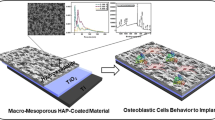Abstract
A recently developed “GRAPE® technology” provides titanium or titanium alloy implants with spontaneous apatite-forming ability in vitro, which requires properly designed gaps and optimum heat treatment in air. In this study, titanium alloy and commercially pure (cp) titanium substrates were thermally oxidized in air before aligning pairs of specimens in the GRAPE® set-up, i.e., titanium alloy and cp titanium substrates were aligned parallel to each other with optimum gap width (spatial design). A liquid phase deposition (LPD) technique was employed for titania coatings on titanium alloy substrate. Then, they were soaked in Kokubo’s simulated body fluid (SBF, pH 7.4, 36.5 °C) for 7 days to confirm the in vitro apatite formation on the substrates under the specific spatial design. Anatase-type titania coatings fabricated by using LPD technique led to the deposition of apatite particles within 7 days and showed apatite X-ray diffraction. On the other hand, thermally oxidized titanium alloy substrate in air and non-treated specimens did not show any apatite X-ray diffraction. These results indicated that the heterogeneous nucleation of apatite induced on anatase-type titania coating prepared by LPD technique when it was aligned parallel to thermally oxidized cp titanium substrate with optimum gap width.








Similar content being viewed by others
References
Duan K, Wang R. Surface modifications of bone implants through wet chemistry. J Mater Chem. 2006;16(24):2309–21.
Rohanizadeh R, Al-Sadeq M, LeGeros RZ. Preparation of different forms of titanium oxide on titanium surface: effects on apatite deposition. J Biomed Mater Res. 2004;71A(2):343–52.
Liu X, Zhao X, Fu RKY, Ho JPY, Ding C, Chu PK. Plasma-treated nanostructured TiO2 surface supporting biomimetic growth of apatite. Biomaterials. 2005;26(31):6143–50.
Uchida M, Kim H-M, Kokubo T, Fujibayashi S, Nakamura T. Structure dependence of apatite formation on titania gels in a stimulated body fluid. J Biomed Mater Res. 2003;64A(1):167–70.
Wang X–X, Hayakawa S, Tsuru K, Osaka A. Bioactive titania gel layers formed by chemical treatment of Ti substrate with a H2O2/HCl solution. Biomaterials. 2002;23(5):1353–7.
Wu J-M, Hayakawa S, Tsuru K, Osaka A. Low-temperature preparation of anatase and rutile layers on titanium substrates and their ability to ınduce in vitro apatite deposition. J Am Ceram Soc. 2004;87(9):1635–42.
Sugino A, Uetsuki K, Tsuru K, Hayakawa S, Osaka A, Ohtsuki C. Surface topography designed to provide osteoconductivity to titanium after thermal oxidation. Mater Trans. 2008;49(3):428–34.
Sugino A, Ohtsuki C, Tsuru K, Hayakawa S, Nakano T, Okazaki Y, Osaka A. Effect of spatial design and thermal oxidation on apatite formation on Ti–15Zr–4Ta–4Nb alloy. Acta Biomater. 2009;5(1):298–304.
Sugino A, Tsuru K, Hayakawa S, Kikuta K, Kawachi G, Osaka A, Ohtsuki C. Induced deposition of bone-like hydroxyapatite on thermally oxidized titanium substrates using a spatial gap in a solution that mimics a body fluid. J Ceram Soc Japan. 2009;117(4):515–20.
Nakao Y, Sugino A, Tsuru K, Uetsuki K, Shirosaki Y, Hayakawa S, Osaka A. Enhancement of apatite-forming ability of parallely aligned Ti-substrates with optimum gaps by autoclaving. J Ceram Soc Japan. 2010;118(6):483–6.
Kokubo T, Takadama H. How useful is SBF in predicting in vivo bone bioactivity? Biomaterials. 2006;27(15):2907–15.
Li P, Ohtsuki C, Kokubo T, Nakanishi K, Soga N, de Groot K. The role of hydrated silica, titania, and alumina in inducing apatite on implants. J Biomed Mater Res. 1994;28(1):7–15.
Uetsuki K, Kaneda H, Shirosaki Y, Hayakawa S, Osaka A. Effects of UV-irradiation on in vitro apatite-forming ability of TiO2 layers. Mater Sci Eng, B. 2010;173(1-3):213–5.
Uetsuki K, Nakai S, Shirosaki Y, Hayakawa S, Osaka A. Nucleation and growth of apatite on an anatase layer irradiated with UV light under different environmental conditions. J Biomed Mater Res. 2013;101A(3):712–9.
Masuda Y, Kato K. Liquid-phase patterning and microstructure of anatase TiO2 films on SnO2:f substrates using superhydrophilic surface. Chem Mater. 2008;20(3):1057–63.
Shozui T, Tsuru K, Hayakawa S, Osaka A. In vitro apatite-forming ability of titania fims depends on their substrates. Key Eng Mater. 2007;330–332:633–6.
Shozui T, Tsuru K, Hayakawa S, Shirosaki Y, Osaka A. XPS study on potential suppression factors of suppressing in vitro apatite formation on anatase films prepared on various substrates. Surf Coat Technol. 2009;203(16):2181–5.
Kim T, Suzuki M, Ohtsuki C, Masuda K, Tamai H, Watanabe E, Osaka A, Moriya H. Enhancement of bone growth in titanium fiber mesh by surface modification with hydrogen peroxide solution containing tantalum chloride. J Biomed Mater Res Part B. 2003;64B(1):19–26.
Acknowledgments
This study was supported by a Grant-in-Aid for Challenging Exploratory Research from the Japan Society for the Promotion of Science.
Author information
Authors and Affiliations
Corresponding author
Rights and permissions
About this article
Cite this article
Hayakawa, S., Masuda, Y., Okamoto, K. et al. Liquid phase deposited titania coating to enable in vitro apatite formation on Ti6Al4V alloy. J Mater Sci: Mater Med 25, 375–381 (2014). https://doi.org/10.1007/s10856-013-5078-z
Received:
Accepted:
Published:
Issue Date:
DOI: https://doi.org/10.1007/s10856-013-5078-z




